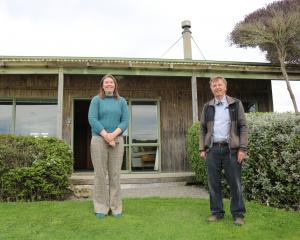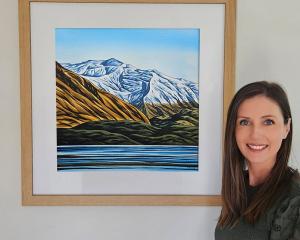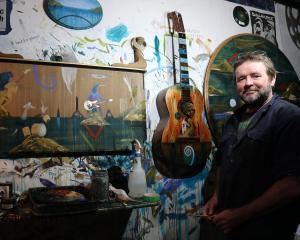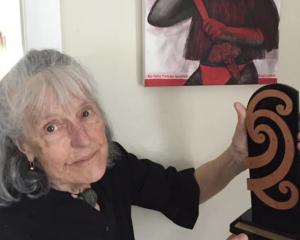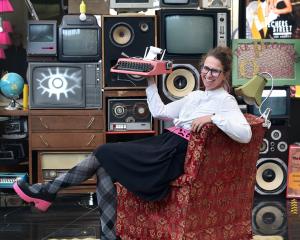Dunedin's historic Globe Theatre has seen plenty of drama. But the past year has been the most dramatic of all. Nigel Benson reports.
A can of worms was opened at the Globe Theatre last year.
''We realised three years ago that work needed to be done. We just didn't realise how much work needed to be done,'' Friends of the Globe chairwoman Rosemary Beresford said.
A condition report and conservation plan identified major problems with the Globe and adjoining William Mason House, including water penetration and a crumbling interior wall.
''The greatest threat facing the Globe is the poor condition of the structure and fabric of the buildings,'' building conservation specialist Robin Miller's report said.
The recommended $500,000 renovation included repairing the roof, walls and floor, but there were further underlying problems.
''The report confirmed the problem was serious and was even more serious than we thought. We realised we also needed to improve the earthquake-protection and fire-resistance,'' Dr Beresford said.
The Historic Places Trust category 1-listed building was built in 1864 by Dunedin's first mayor and New Zealand's first registered architect, William Mason, who co-founded Mason and Wales.
The octagonal theatre, inspired by Elizabethan theatres, was later designed by Niel Wales, a Mason and Wales partner. But for the past year, protective tarpaulins have been spread over the stage area and audience seating between shows.
''We have to put tarps out every night after performances, to keep the water out,'' theatre committee member Don Knewstubb said.
''The back corners of the stage are particularly prone to leaking. There's just a line of drips. The roof has been leaking water for the last seven decades.''
About 50 people attended an ambitious fundraising appeal launch at the theatre last September to raise the required $500,000 for the project.
''There's been so much love for the Globe in Dunedin over the years and we want to make sure it will continue for many years to come,'' Dr Beresford said.
''People have been very responsive and generous. We've had support from local and national organisations. Even with the kiddy shows we've seen that, at the end of the week, the audiences have dropped $8 or $10 in the donation box, which is nice.''
However, much of the pledged funding is contingent on the full $500,000 being raised by October.
''We started fundraising last October and we need to raise another $120,000 by October 16 to access the lottery money. They gave us 12 months to get the rest of the money together. We've got the builder standing by,'' Dr Beresford said.
Globe founder Patric Carey came to Dunedin, with wife Rosalie, in 1956 as the Dunedin Repertory Society's first professional director.
The couple was soon staging ancient Greek plays in gardens, churches and hired venues, before building a 30-seat theatre at their 104 London St home with the help of friends in 1961.
The Globe Theatre quickly became a focus for Dunedin's artistic community, with supporters including poet James K. Baxter, artist Ralph Hotere and philanthropist Charles Brasch.
The Globe celebrated avant-garde playwrights such as Samuel Beckett, Jean Paul Sartre and Tennessee Williams and classic writers like Chekhov, Ibsen and George Bernard Shaw.
It was the first theatre in New Zealand and Australia to produce Beckett's Waiting for Godot and held regular performances of works by Shakespeare, Sophocles and Moliere.
The couple promoted classical, contemporary and experimental theatre, dance and concerts and championed New Zealand writers, such as James K. Baxter, R. A. K. Mason, Janet Frame, Robert Lord and John Caselberg.
Artists Colin McCahon and Ralph Hotere exhibited there and Hotere even designed sets and costumes for productions.
''The programme the Careys followed was always looking for provocative material and that's something we try to continue today,'' Don Knewstubb said.
''At the 50th anniversary of the Globe [in 2011], it was notable how many former members said the Globe was the start of their real education. It opened their eyes to things that weren't happening elsewhere.''
Dunedin had never seen anything like the Globe and it quickly caught the imagination of local artists, writers, academics, students and theatre-lovers.
''Patric and Rosalie were regarded not only with huge respect, but also great affection, by those who worked with them,'' Mr Knewstubb said.
The Globe was the first purpose-built theatre run by professional directors in the country and became a magnet for the creative and curious, former-Dunedin MP Stan Rodger said.
''There used to be a whole raft of slightly eccentric people in Dunedin. A lot of them congregated at the Globe. It has been a generator of a huge amount of artistic talent,'' he said.
''It gives an outlet to people who want to be part of a theatrical scene. It encourages young people to take part in theatre. It has programmes pitched for them. My daughter, Gillian, learned lighting here and she is now an electrical engineer.''
The 30-seat ''theatre in a house'' was later modified into the 72-seat theatre which exists today.
''The Globe did a lot of work with the university, in the old days. It did a lot of Russian, French and German plays,'' Friend of the Globe and veteran television producer Lorraine Isaacs recalled.
''I was in a Russian play there, a million years ago.''
For the global coterie of artists, poets, writers, academics, actors and students, the theatre was a scene of stimulating, provocative and erudite conversation.
The Careys separated in 1973 and the operation of the theatre was taken over by the Friends of the Globe Theatre. Mrs Carey returned to Wellington, where she continued teaching, writing and acting, before moving to Whangarei.
In 1999, she wrote a history of the Globe, A Theatre in the House: The Careys' Globe, published by University of Otago Press.
Mr Carey died in Gore in 2006. Mrs Carey made a final bow on the Globe stage in April, 2007, aged 86, when she visited Dunedin to promote her autobiography, It's Not What You Know.
In 2010, she was made a Member of the New Zealand Order of Merit for services to the theatre. She died in Whangarei in 2011.
Apparitions: that's the spirit!
Ghosts are helping raise funds for the renovation of the Globe Theatre.
Gold and silver ghost-shaped plaques inscribed with the names of donors are raising spirits and bringing in money.
A paranormal investigation group, The Other Side, claimed to discover ghostly apparitions when it conducted experiments at the Globe in 2012.
The group identified the spirits as Mary Elizabeth Richmond, who lived in the building when it was a cottage in the 1860s; Robert Blackadder, a resident in the 19th century before it became a theatre; and former theatre caretaker Frank Grayson, who died in the 1980s.
''I think it's safe to say the caretaker, Frank, is still there. He is just there looking after the place, basically.'' paranormal investigator Kelly Cavanagh said.
''There is definitely still persons there, but they are just there because they are there. They are not there to scare people.''
How to help
Donations may be made via the Givealittle site: www.givealittle.co.nz/org/globetheatre
Buy a named seat plaque: $50 for silver or $100 for gold.
Buy a named theatre ghost: $500 for silver, $1000 for gold and $5000 for platinum.
Make a donation: Make cheques out to The Friends of the Globe Theatre, or bank transfer to the Globe's project fund account: 03 0903 0451937 017.

